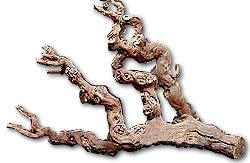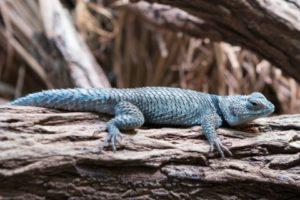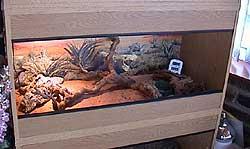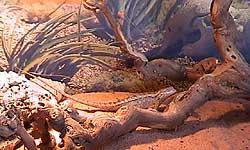This is reptilesly desert Spiny Lizard Care Sheet.
A well laid out desert vivarium is a wonderful sight.
This type of set up is based on the dry desert and is suitable for Desert Spiny Lizards (Sceloporus magister), Crevice Spiny Lizard (Sceloporus poinsetti) and similarly sized desert species.
There are lots of desert creatures that can be kept in a desert vivarium some scorpions, insects, snakes and lizards.
Spiny Lizard Care Sheet
The vivarium below is a 36 inch long melamine vivarium, this size is the minimum recommended for lizards of around 12 inches long.
Other sized lizards will have different requirements as shown below:
These measurements are of course the minimum requirements but you can always move up to a larger enclosure if you want. READ MORE: Tokay Gecko Guide
For larger reptiles the enclosure may need to be wider and taller rather than just longer. e.g. 72 x 36 x 24
The substrate in the desert vivarium is usually calcium sand or a sand and gravel mix, this should be a minimum of 3 times as deep as the lizard is thick - e.g. a lizard is around 1 inch thick from its back to its belly there for the substrate is 3 x 1 inch = 3 inches deep.
This is because many lizards bury themselves under the sand and lay in wait for the odd insect that strays too close!
Almost all desert lizards are also good climbers, this must be provided in the habitat in order for them to act naturally.
A well branched piece of natural grape wood makes a perfect climbing frame for desert lizards.

In addition to a climbing frame all the lizards will require somewhere to hide. You can use a pile of rocks, a pre fabricated cave, piles of natural cork bark or similar items.
If you use rocks it is a good idea to assemble the rock pile outside the vivarium and glue all the bits together using a suitable silicone sealant.

This will prevent the rocks colapsing and possibly harming your reptiles.
Place a rock pile at both the warm end under the spot light and at the cool end where there is no extra heating, this will allow the reptile to select either a warm retreat or a cool one.
Heating a desert vivarium will depend on the intended guest, in most cases a heat mat can be used under the sand.
Additional daytime heating should be provided by a spot light at one end of the enclosure, this should be pointing at a suitable basking area (pile of rocks etc).
To maintain the correct temperature for the reptiles you can install a thermostat to control the heating equipment.
A mat stat is intended for use with a heating mat and turns it on and off to reach a desired temperature you selected on the front dial.
A more complex type would be a dimming day/night thermostat which can be set to adjust the power going to the mat, spot light etc depending on whether it's day or night.
The lizards will mostly be active during the day so will need exposing to UV light in the form of a UV strip light, select one that emits 5% - 7% UVB.
The UV light and spot light should be turned on at 8am and off at 8pm or any other 12 hour combination, you can use a simple electronic timer to accomplish this.
All animals need fresh water to survive and desert reptiles are no different.
Place a shallow bowl of water (5 x 3 inches) in the enclosure and change it daily.
The fully finished set up looks like a piece of furniture and fits in almost anywhere.


Here a Desert Spiny Lizards (Sceloporus magister) is out of his hide.
